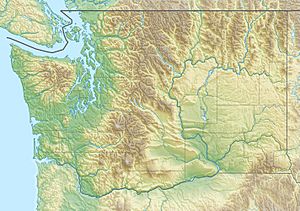Mashel River facts for kids
Quick facts for kids Mashel River |
|
|---|---|
|
Location of the mouth of the Mashel River in Washington
|
|
| Country | United States |
| State | Washington |
| County | Pierce County |
| City | Eatonville, Washington |
| Physical characteristics | |
| Main source | An unnamed lake Cascade Range, Pierce County, Washington 4,340 ft (1,320 m) 46°50′33″N 122°1′26″W / 46.84250°N 122.02389°W |
| River mouth | Nisqually River Southwest of Eatonville, Pierce County, Washington 482 ft (147 m) 46°50′31″N 122°20′2″W / 46.84194°N 122.33389°W |
| Basin features | |
| Basin size | 80.7 sq mi (209 km2) |
The Mashel River is a river located in Pierce County, in the U.S. state of Washington. It's a smaller river that flows into the Nisqually River. The Mashel River joins the Nisqually about 3.6 miles (5.8 km) northwest of Eatonville.
Contents
The River's Journey
The Mashel River begins from a tiny, unnamed lake. This lake is found about 5.1 miles (8.2 km) southeast of Mount Beljica. The river starts as a small stream flowing northwest. Then it turns west and later south.
The South Fork Mashel River joins the main river at this point. After this, the Mashel River turns west again. It is then joined by Busy Wild Creek. About 3.5 miles (5.6 km) downstream, Beaver Creek also flows into the Mashel.
The Mashel River continues west for about 2.7 miles (4.3 km). It then turns southwest, following the southern edge of Eatonville for about 1.7 miles (2.7 km). The Little Mashel River joins the main river shortly after it leaves Eatonville's city limits.
George Smallwood Park is located near this area. It is named after a former mayor of Eatonville. After the Little Mashel River joins, the Mashel flows west for another 1.1 miles (1.8 km). It then passes under Highway 7. Finally, it gradually turns south and empties into the Nisqually River.
South Fork Mashel River
The South Fork Mashel River starts from another small, unnamed lake. This lake is just east of where the main river begins. It is only 29 feet (8.8 m) lower in elevation.
The South Fork flows generally northwest from its source. It travels about 4.3 miles (6.9 km) to where it meets the main Mashel River. The South Fork does not have any large tributaries. However, many smaller streams flow into it. Near its mouth, the South Fork flows over a waterfall.
Boxcar Canyon
Boxcar Canyon is a part of the Mashel River that ends about 1 mile (1.6 km) upstream from Eatonville. This area used to be a popular spot for camping and other activities. Unfortunately, some of these activities led to pollution and damage to the river and canyon.
The city of Eatonville has tried to clean up the area. A big cleanup happened in 2004, but it didn't make a lasting difference. The canyon was even closed, and signs were put up to protect the land. Sadly, many signs were damaged or removed quickly.
A railroad bridge that crossed Boxcar Canyon burned down many years ago. This happened in the late 1970s or early 1980s. The tall wooden structure caught fire easily.
Because of the pollution and damage, it has become hard for fish to lay their eggs (spawn) in the canyon. This used to be a common sight. To help protect the fish, the Nisqually Land Trust has bought the canyon. They also bought land around it and a large section of the river downstream from Eatonville.
Fish in the River
The Mashel River is home to four types of salmonid fish. These include rainbow trout (also known as steelhead), Chinook salmon, coho salmon, and pink salmon. Of these, the steelhead and Chinook salmon are the most at risk. They are considered endangered.
Helping Fish with Logjams
Recently, people have placed large piles of logs, called logjams, into the river. This is done to help salmon reproduce better. Many trees along the river, especially in the upper parts, have been cut down over time. This means fewer natural logjams form.
These new logjams help the river in several ways. They trap leaves and create deep pools of water. Salmon traveling upstream can rest in these calm, deep pools. The coho salmon have especially benefited from these added logjams.
Tributaries
- Beaver Creek
- Busy Wild Creek
- Little Mashel River



